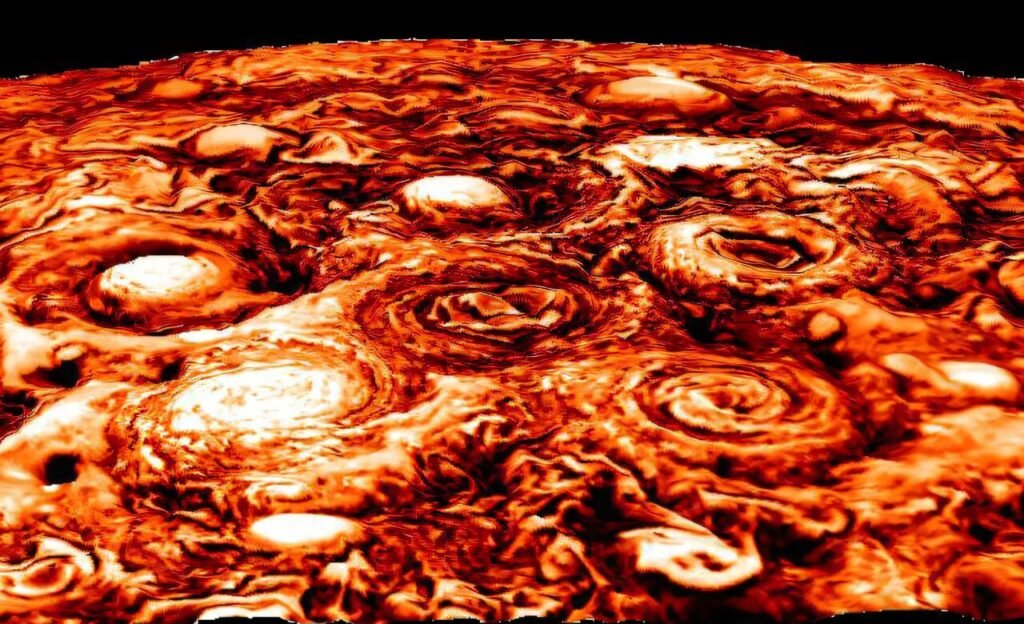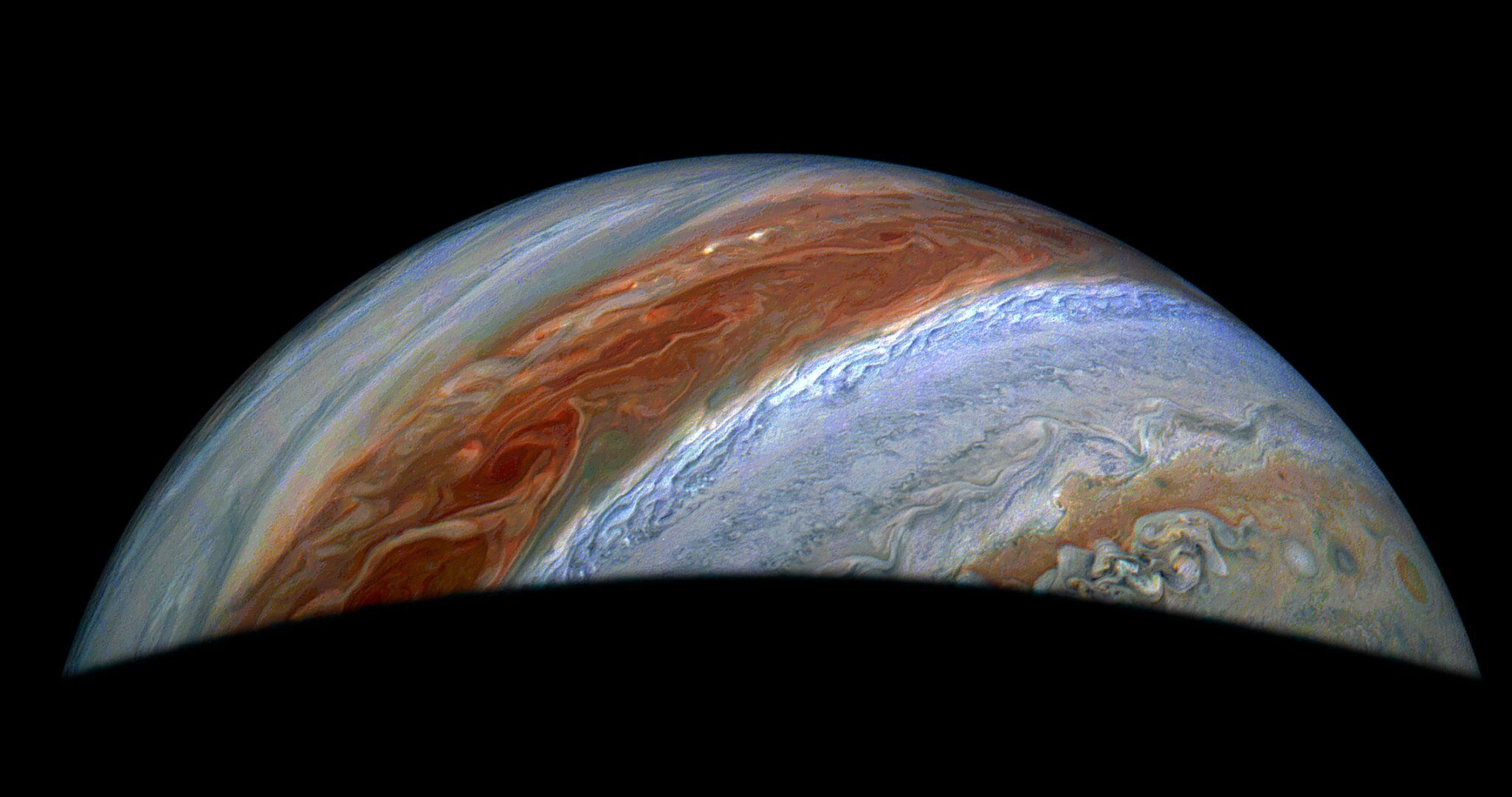Far beyond the comforting glow of Earth’s sunrises and sunsets lies a realm of extremes—a realm where winds howl with ferocity, volcanoes never sleep, and radiation belts lash any intruding spacecraft with invisible fury. This is the domain of Jupiter, the largest planet in our solar system, and its volatile moon Io, the most volcanically active body known. Now, new insights from NASA’s Juno mission are pulling back the curtain on this alien theater of atmospheric chaos and subterranean fire, revealing secrets that challenge our understanding of planetary physics and geological forces.
From colossal polar cyclones to lava lakes hidden beneath a moon’s crust, the discoveries come as part of Juno’s bold, ongoing exploration of the Jovian system. Announced at the European Geosciences Union General Assembly in Vienna on April 29, these revelations illustrate the incredible complexity of both Jupiter’s upper atmosphere and Io’s subsurface dynamism.
Peering Beneath the Clouds of a Giant
When NASA’s Juno spacecraft launched in 2011, its mission was clear: to unravel the mysteries of Jupiter by flying closer than any spacecraft before it, mapping its magnetic field, probing its deep atmosphere, and deciphering the weather patterns of a planet where storms dwarf continents. After arriving in 2016, Juno has repeatedly dived into the gas giant’s intense environment, collecting data that continues to redefine planetary science.

Its latest findings delve into the north polar region of Jupiter, where cyclones larger than Australia spin with unrelenting energy. These are not your average planetary storms. They are structured, semi-permanent weather systems that move with an eerie elegance, caught in a gravitational dance few fully understood—until now.
Utilizing the combined power of JunoCam, the Jovian Infrared Auroral Mapper (JIRAM), and radio science tools, scientists have observed how these polar cyclones drift, cluster, and stabilize due to an intriguing process called beta drift. On Earth, beta drift explains how hurricanes slowly migrate poleward. But on Jupiter, this migration never ends in destruction—because there’s no land to slow the storms down, no temperature drop-off to sap their strength. Instead, Jupiter’s cyclones approach the pole and begin to interact with neighboring cyclones, bouncing and spinning around one another like pendulums in a giant cosmic mobile.
“It’s like watching springs in a clockwork system,” explained Yohai Kaspi, Juno co-investigator from Israel’s Weizmann Institute of Science. “Each cyclone is affected by its neighbors, not in chaotic ways, but in orchestrated, rhythmic motions. It’s a gravitational choreography.”
The Chill of the Polar Stratosphere
In a separate set of observations, Juno’s radio occultation experiment offered an unprecedented glimpse into the thermal structure of Jupiter’s atmosphere. By transmitting radio waves from Earth to the spacecraft and back, passing them through layers of Jupiter’s atmosphere, researchers were able to detect how temperature and density changed with altitude.
What they found was astonishing: Jupiter’s north polar stratospheric cap is about 11°C (20°F) cooler than its surrounding regions, and it is bounded by fierce jet stream winds exceeding 100 miles per hour (161 kph). This colder cap is the first of its kind to be directly measured and represents a striking parallel to polar dynamics on Earth and Saturn, offering scientists a comparative framework for understanding atmospheric systems across the solar system.
With 26 radio occultation passes completed so far, Juno has begun mapping the atmospheric layers of Jupiter with a precision unmatched by previous missions, helping refine models of wind shear, heat transport, and possibly even the processes that fuel the planet’s intense auroras.
Io’s Subsurface Secrets: A Moon in Perpetual Eruption
But Jupiter is not the only celestial object under Juno’s gaze. One of the most thrilling revelations comes not from the gas giant itself, but from Io, the volcanic hellscape of a moon orbiting just 262,000 miles (422,000 km) away.
Using Juno’s Microwave Radiometer (MWR)—originally designed to study Jupiter’s deep atmosphere—scientists turned their attention to Io’s surface and found something unexpected: a heat map of active magma, slowly cooling beneath the moon’s crust. By pairing this data with high-resolution infrared images from JIRAM, they were able to construct a temperature profile of Io’s subsurface—the first of its kind.
What they discovered is that beneath almost 10% of Io’s surface, there are still-warm lava flows from relatively recent eruptions. These flows haven’t cooled completely and exist just below the surface, creating a thermal feedback system that scientists liken to a radiator.
“Io’s volcanic plains are like the engine of a car,” said Shannon Brown, Juno scientist at NASA’s Jet Propulsion Laboratory. “They push heat outward, radiating energy away and cooling the moon’s interior, all while creating new surface features at a pace unrivaled in the solar system.”
The evidence also confirms that Io’s most energetic eruption in recorded history, first spotted by JIRAM in December 2024, remained active well into March 2025 and may still be erupting. This long-duration eruption may hold clues to how massive lava fields form and persist on other celestial bodies, from Mars to potentially volcanic exoplanets.
Volcanoes that Never Sleep
Io’s volcanic activity stems from a gravitational tug-of-war. The moon is locked in a resonant orbit with Europa and Ganymede, creating tidal forces that flex its crust and superheat its interior. This process—tidal heating—powers Io’s network of over 400 active volcanoes and constantly resurfaces the moon with fresh lava.
These findings may not only redefine our understanding of how heat escapes from solid planetary bodies, but also how geological processes evolve on moons and planets with no tectonic plates. In fact, scientists believe Io’s method of crust renewal through volcanic recycling could represent an alternative model for geological activity beyond Earth.
Moreover, the ability to detect magma beneath the surface—without ever landing—may someday prove essential in the search for subsurface oceans or geothermal energy on icy moons like Europa or Enceladus.
Juno: The Indestructible Explorer
Navigating such a brutal environment is no easy feat. Jupiter’s radiation belts are the most intense in the solar system—vast regions filled with high-energy particles that can fry spacecraft electronics. But Juno was built like a tank, armored with titanium to shield its sensitive instruments.
As part of its extended mission, Juno’s orbit is constantly shifting, allowing it to explore new latitudes, new longitudes, and even dive into regions no spacecraft has dared venture before. With every new flyby—like the upcoming close encounter with Io on May 6, 2025—Juno inches closer to understanding not just the physics of distant planets, but the very mechanics of planetary systems.
“We’ve gone farther, deeper, and risked more with Juno than almost any other mission,” said Scott Bolton, the mission’s principal investigator. “Every new orbit gives us a different perspective—sometimes quite literally—and each one brings us closer to answering the big questions about how giant planets work, and how they shape the solar system around them.”
From Gas Giants to Earth’s Weather
While the scientific payoff of Juno is tremendous for understanding Jupiter and its moons, the implications stretch much further. Jupiter, as a miniature solar system of its own, serves as a natural laboratory for understanding not only planetary formation but also weather dynamics, magnetism, and internal heating mechanisms that might apply to other worlds—including Earth.
For instance, the behavior of Jupiter’s cyclones can refine climate models here on Earth. And the techniques developed to measure heat beneath Io’s crust could be adapted for non-invasive subsurface exploration on our planet or Mars. The insights from Juno feed into our broader understanding of planetary evolution, habitability, and even the dynamics of exoplanets that orbit other stars.
A Universe of Extremes, Revealed One Orbit at a Time
The Juno mission continues to be a triumph of human ingenuity and scientific ambition. As it threads its way through a labyrinth of radiation and gravitational forces, it offers not just data, but perspective—on how the cosmos works, and how our own world fits into its vast tapestry.
From the screaming jet streams of Jupiter to the molten underworld of Io, we are witnessing the power, beauty, and mystery of a solar system that still has much to teach us. Thanks to Juno, we are no longer just looking at the gas giant from afar. We are diving into its depths, flying with its storms, and walking—if only in our imagination—across the molten plains of its moon.
And the journey is far from over.
Loved this? Help us spread the word and support independent science! Share now.
